Abstract
The passive hemagglutination test for antibodies against the enterobacterial common antigen (ECA) of Kunin was standardized for diagnostic purposes. Human erythrocytes were coated with a soluble ECA+ preparation from Salmonella typhimurium or, as specificity controls, with a similar ECA- preparation from congenic ECA-negative bacteria with saline, and the hemagglutination assay was performed on microtiter plates. The specificity of the test was ascertained further by inhibition assays with purified ECA and with crude ECA+ and ECA- preparations. The reproducibility of the tests was 96.4%; on this basis, a fourfold or larger difference in titers was regarded as significant. The anti-ECA titers in 649 serum samples from healthy persons ranged from less than 4 to 8,192. The titers increased with age, so that th geometric mean titers were 57 at 1.5 years of age and 201 at 45 years of age. After this, the titers decreased again, to a low of 52 in persons more than 70 years old. Women had higher titers than men up to the age of 40 years.
Full text
PDF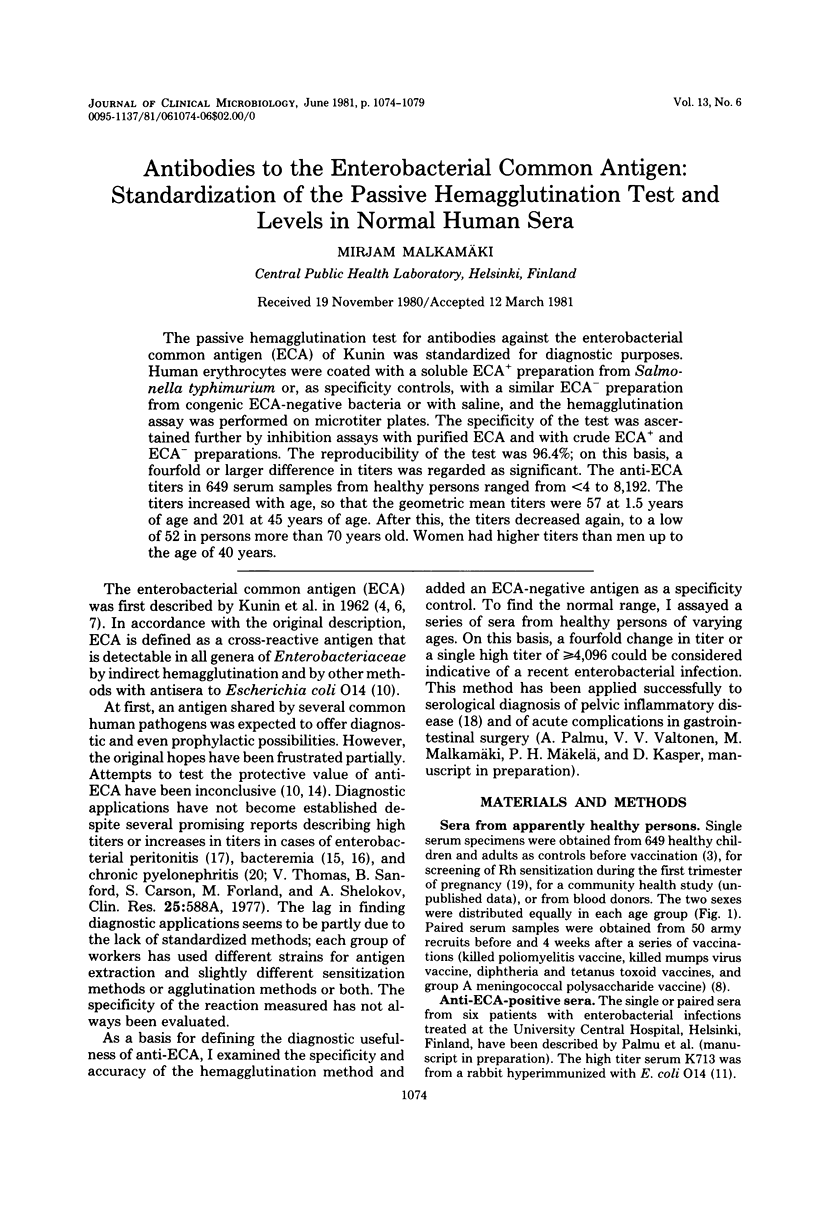
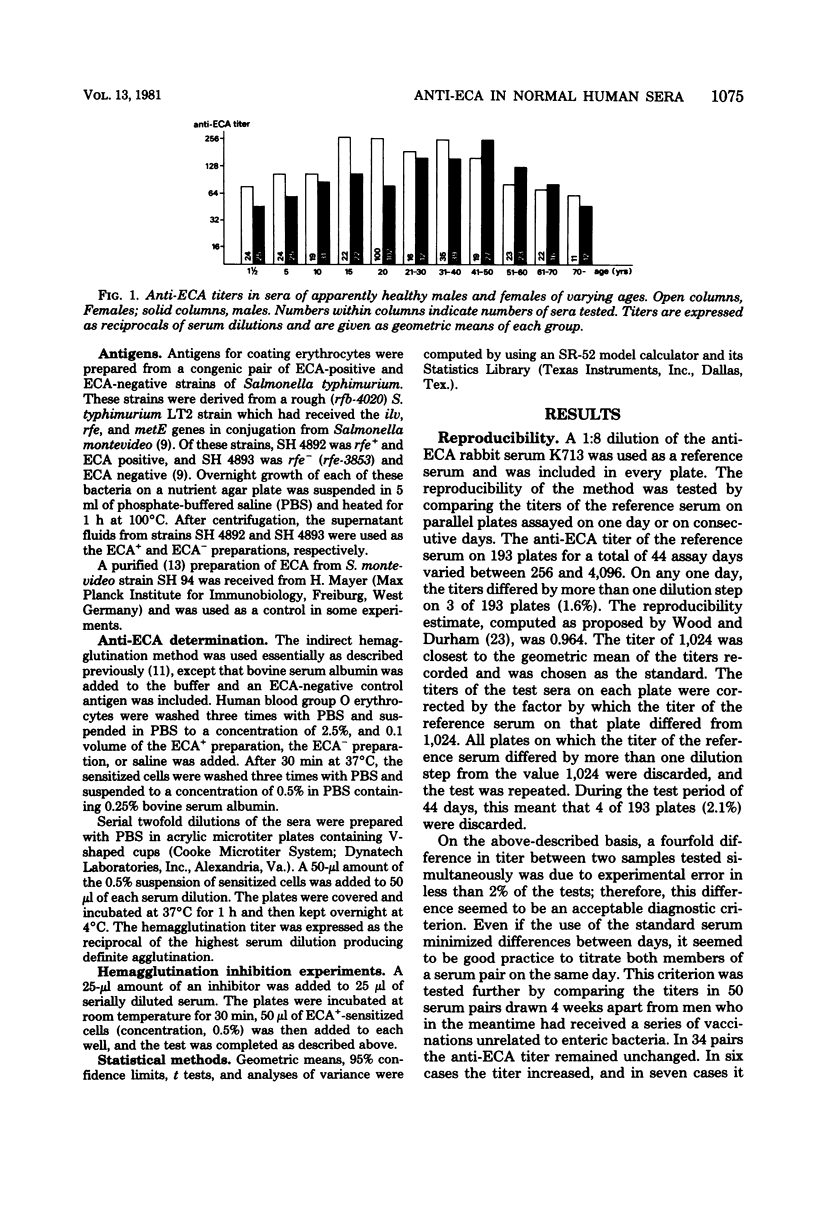
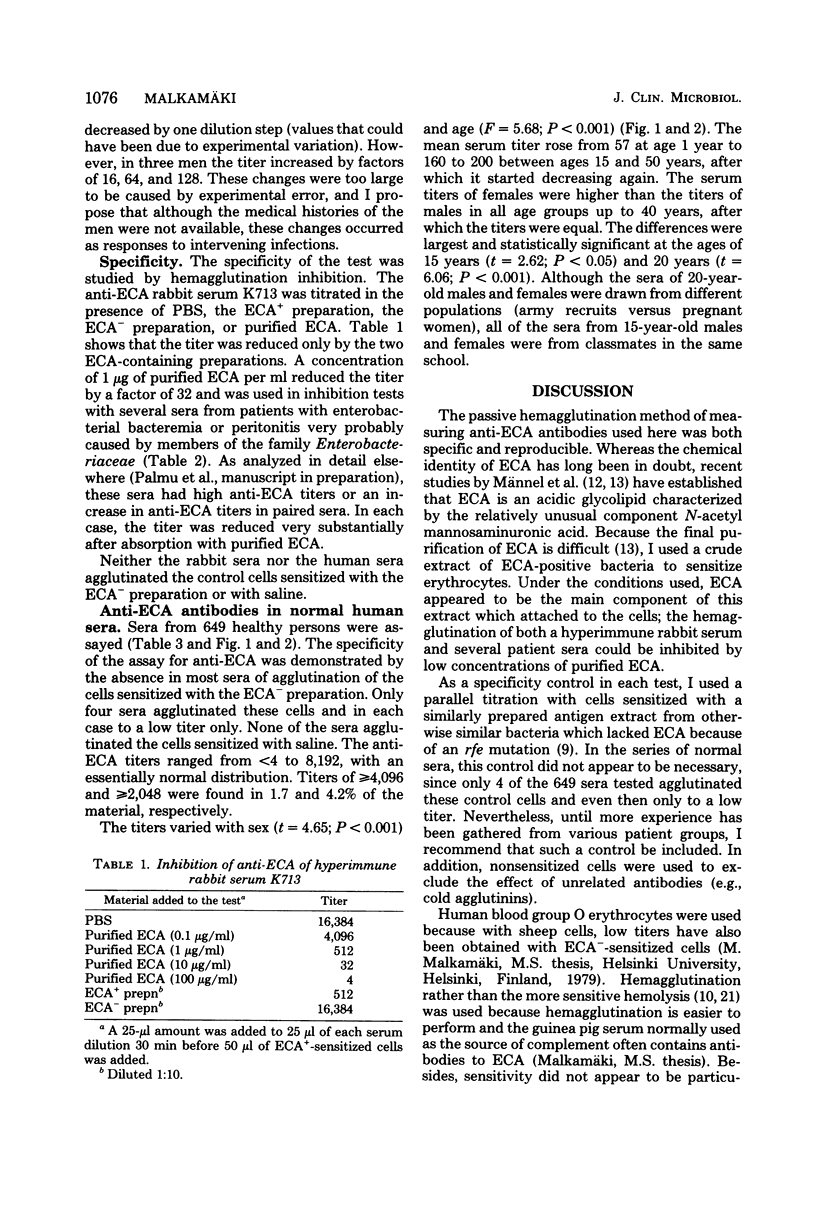
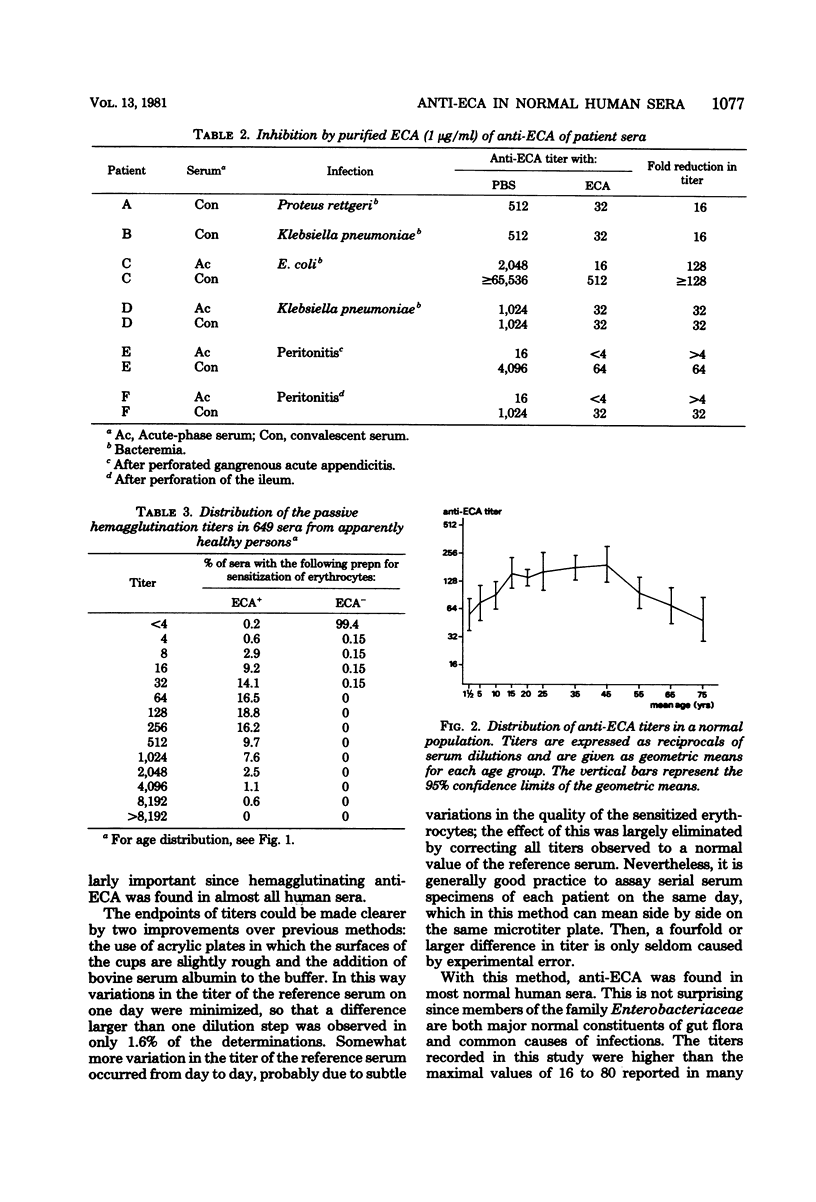
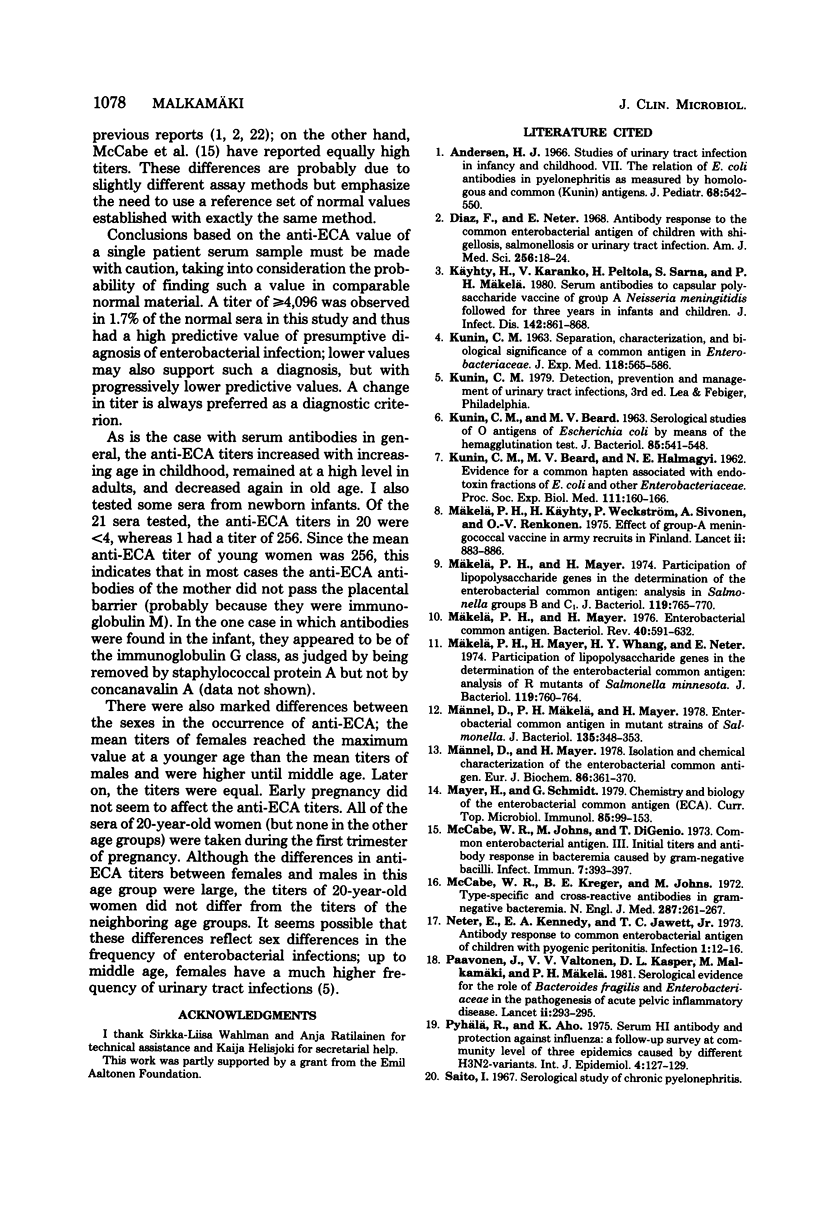
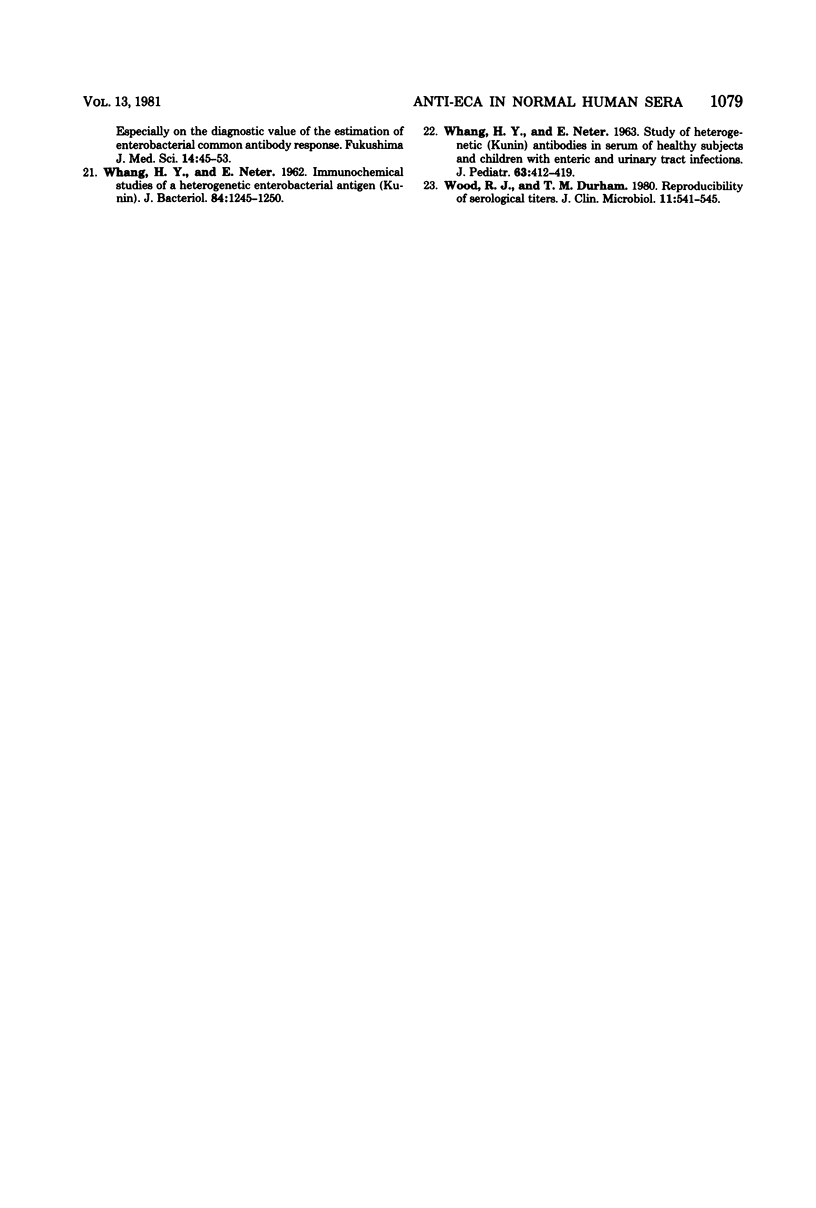
Selected References
These references are in PubMed. This may not be the complete list of references from this article.
- Diaz F., Neter E. Antibody response to the common enterobacterial antigen of children with shigellosis, salmonellosis or urinary tract infection. Am J Med Sci. 1968 Jul;256(1):18–24. doi: 10.1097/00000441-196807000-00003. [DOI] [PubMed] [Google Scholar]
- KUNIN C. M., BEARD M. V. SEROLOGICAL STUDIES OF O ANTIGENS OF ESCHERICHIA COLI BY MEANS OF THE HEMAGGLUTINATION TEST. J Bacteriol. 1963 Mar;85:541–548. doi: 10.1128/jb.85.3.541-548.1963. [DOI] [PMC free article] [PubMed] [Google Scholar]
- KUNIN C. M. SEPARATION, CHARACTERIZATION, AND BIOLOGICAL SIGNIFICANCE OF A COMMON ANTIGEN IN ENTEROBACTERIACEAE. J Exp Med. 1963 Oct 1;118:565–586. doi: 10.1084/jem.118.4.565. [DOI] [PMC free article] [PubMed] [Google Scholar]
- Käyhty H., Karanko V., Peltola H., Sarna S., Mäkelä P. H. Serum antibodies to capsular polysaccharide vaccine of group A Neissera meningitidis followed for three years in infants and children. J Infect Dis. 1980 Dec;142(6):861–868. doi: 10.1093/infdis/142.6.861. [DOI] [PubMed] [Google Scholar]
- Mayer H., Schmidt G. Chemistry and biology of the enterobacterial common antigen (ECA). Curr Top Microbiol Immunol. 1979;85:99–153. doi: 10.1007/978-3-642-67322-1_3. [DOI] [PubMed] [Google Scholar]
- McCabe W. R., Johns M., DiGenio T. Common enterobacterial antigen. 3. Initial titers and antibody response in bacteremia caused by gram-negative bacilli. Infect Immun. 1973 Mar;7(3):393–397. doi: 10.1128/iai.7.3.393-397.1973. [DOI] [PMC free article] [PubMed] [Google Scholar]
- McCabe W. R., Kreger B. E., Johns M. Type-specific and cross-reactive antibodies in gram-negative bacteremia. N Engl J Med. 1972 Aug 10;287(6):261–267. doi: 10.1056/NEJM197208102870601. [DOI] [PubMed] [Google Scholar]
- Mäkelä P. H., Käyhty H., Weckström P., Sivonen A., Renkonen O. V. Effect of group-A meningococcal vaccine in army recruits in Finland. Lancet. 1975 Nov 8;2(7941):883–886. doi: 10.1016/s0140-6736(75)92125-x. [DOI] [PubMed] [Google Scholar]
- Mäkelä P. H., Mayer H. Enterobacterial common antigen. Bacteriol Rev. 1976 Sep;40(3):591–632. doi: 10.1128/br.40.3.591-632.1976. [DOI] [PMC free article] [PubMed] [Google Scholar]
- Mäkelä P. H., Mayer H., Whang H. Y., Neter E. Participation of lipopolysaccharide genes in the determination of the enterobacterial common antigen: analysis of R mutants of Salmonella minnesota. J Bacteriol. 1974 Sep;119(3):760–764. doi: 10.1128/jb.119.3.760-764.1974. [DOI] [PMC free article] [PubMed] [Google Scholar]
- Männel D., Mayer H. Isolation and chemical characterization of the enterobacterial common antigen. Eur J Biochem. 1978 May 16;86(2):361–370. doi: 10.1111/j.1432-1033.1978.tb12318.x. [DOI] [PubMed] [Google Scholar]
- Männel D., Mäkelä P. H., Mayer H. Enterobacterial common antigen in mutant strains of Salmonella. J Bacteriol. 1978 Aug;135(2):348–353. doi: 10.1128/jb.135.2.348-353.1978. [DOI] [PMC free article] [PubMed] [Google Scholar]
- Neter E., Kennedy E. A., Jewett T. C., Jr Antibody response to common enterobacterial antigen of children with pyogenic peritonitis. Infection. 1973;1(1):12–16. doi: 10.1007/BF01638249. [DOI] [PubMed] [Google Scholar]
- Paavonen J., Valtonen V. V., Kasper D. L., Malkamäki M., Mäkelä P. H. Serological evidence for the role of Bacteroides fragilis and enterobacteriaceae in the pathogenesis of acute pelvic inflammatory disease. Lancet. 1981 Feb 7;1(8215):293–295. doi: 10.1016/s0140-6736(81)91909-7. [DOI] [PubMed] [Google Scholar]
- Pyhälä R., Aho K. Serum HI antibody and protection against influenza: a follow-up survey at community level of three epidemics caused by different H3N2-variants. Int J Epidemiol. 1975 Jun;4(2):127–129. doi: 10.1093/ije/4.2.127. [DOI] [PubMed] [Google Scholar]
- WHANG H. Y., NETER E. STUDY OF HETEROGENETIC (KUNIN) ANTIBODIES IN SERUM OF HEALTHY SUBJECTS AND CHILDREN WITH ENTERIC AND URINARY TRACT INFECTIONS. J Pediatr. 1963 Sep;63:412–419. doi: 10.1016/s0022-3476(63)80429-1. [DOI] [PubMed] [Google Scholar]
- Wood R. J., Durham T. M. Reproducibility of serological titers. J Clin Microbiol. 1980 Jun;11(6):541–545. doi: 10.1128/jcm.11.6.541-545.1980. [DOI] [PMC free article] [PubMed] [Google Scholar]


